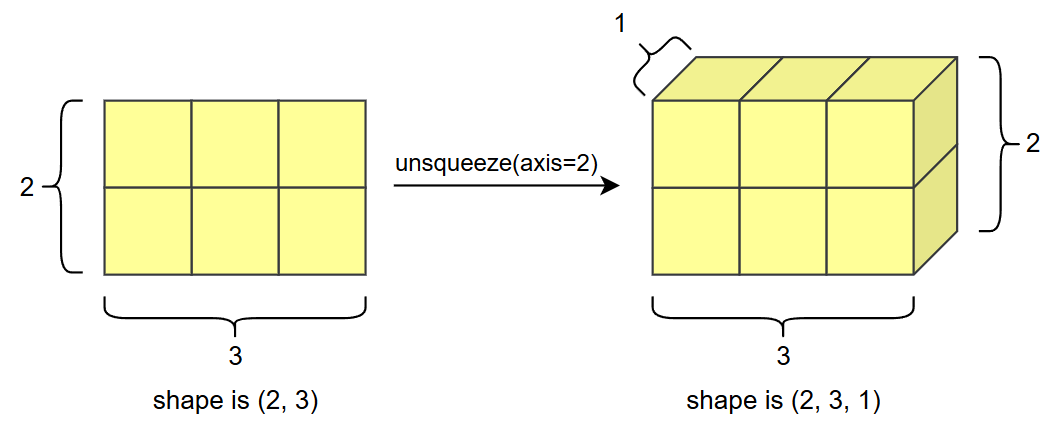unsqueeze
向输入 Tensor 的 Shape 中一个或多个位置(axis)插入尺寸为 1 的维度。
请注意,在动态图模式下,输出 Tensor 将与输入 Tensor 共享数据,并且没有 Tensor 数据拷贝的过程。 如果不希望输入与输出共享数据,请使用 Tensor.clone,例如 unsqueeze_clone_x = x.unsqueeze(-1).clone() 。
下图展示了一个 Shape 为 [2, 3] 的 Tensor 如何使用 unsqueeze 方法在最后一个位置(axis = 2)增加一个维度,从二维变成三维。

额外的,当需要在多个位置增加维度时, unsqueeze 方法会按顺序依次增加维度。例如 Shape 为 [2, 3] 的 Tensor 在 axis = [0, 2] 处增加维度, unsqueeze 方法会先在 axis = 0 前插入一个维度, Shape 变为 [1, 2, 3],接着在 axis = 2 前插入一个维度, Shape 最终变为 [1, 2, 1, 3]。
备注
别名支持: 参数名 input 可替代 x,参数名 dim 可替代 axis,如 unsqueeze(input=tensor_x, dim=1) 等价于 unsqueeze(x=tensor_x, axis=1)。
参数
x (Tensor) - 输入的 Tensor,数据类型为:bfloat16、float32、float64、bool、int8、int32、int64。别名:
input。axis (int|list|tuple|Tensor) - 表示要插入维度的位置。数据类型是 int32。如果 axis 的类型是 list 或 tuple,它的元素可以是整数或者形状为[]的 0-D Tensor。如果 axis 的类型是 Tensor,则是 1-D Tensor。如果 axis 是负数,则 axis=axis+ndim(x)+1 。别名:
dim。name (str,可选) - 具体用法请参见 api_guide_Name,一般无需设置,默认值为 None。
返回
Tensor,扩展维度后的多维 Tensor,数据类型与输入 Tensor 一致。
代码示例
>>> import paddle
>>> x = paddle.rand([5, 10])
>>> print(x.shape)
[5, 10]
>>> out1 = paddle.unsqueeze(x, axis=0)
>>> print(out1.shape)
[1, 5, 10]
>>> out2 = paddle.unsqueeze(x, axis=[0, 2])
>>> print(out2.shape)
[1, 5, 1, 10]
>>> axis = paddle.to_tensor([0, 1, 2])
>>> out3 = paddle.unsqueeze(x, axis=axis)
>>> print(out3.shape)
[1, 1, 1, 5, 10]
>>> # out1, out2, out3 share data with x in dygraph mode
>>> x[0, 0] = 10.
>>> print(out1[0, 0, 0])
Tensor(shape=[], dtype=float32, place=Place(cpu), stop_gradient=True,
10.)
>>> print(out2[0, 0, 0, 0])
Tensor(shape=[], dtype=float32, place=Place(cpu), stop_gradient=True,
10.)
>>> print(out3[0, 0, 0, 0, 0])
Tensor(shape=[], dtype=float32, place=Place(cpu), stop_gradient=True,
10.)